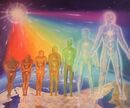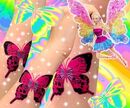Cyberdelic (now known as Virtualcore) is a term used to the immersion in cyberspace as a psychedelic experience. The fusion of cyberculture and the psychedelic subculture into a new counterculture of the 1980s and 1990s. Its chief spokesperson, Timothy Leary, was a popular figure in the Hippie counterculture movement due to his strong endorsement of utilizing psychedelic drugs (specifically LSD), and then got on board with the Cyberdelic movement to push virtual reality (as well as the utilization of "smart drugs") as the wave of the future to create a potential futuristic utopia in place of psychedelics. While the Cyberdelic movement faded after the dot.com bubble burst in 2000, it has since gained ground again in the modern era as a form of escapism from the increasingly-dystopic reality that we currently face.
Much like the Hippies and Psychedelica, Cyberdelic is consistently linked with the Cyberpunk aesthetic of the 80's, though it should be noted the two are separate aesthetics in their own right.
Visual
Cyberdelic aesthetics can be very similar to Vaporwave, Seapunk, and Arcadecore, but with more of a focus on polygonal graphic from the 90's that one would often see in Playstation 1, Sega Saturn, and Nintendo 64; bright, colorful, and charmingly retro (which it shares in common with Rainbowcore, Teencore, and Kidcore), that were popular in old school 90's virtual reality games.
Fashion
Cyberdelic fashion borrows heavily from elements of Cyberpunk and Cybergoth fashions (which makes sense, given Cyberdelic's close ties with the Cyberpunk culture in the 80s) with slight elements of Nintencore and Vaporwave mixed in for good measure. It's very bright, colorful, and cheery, but with a technological twist (a lot of LED charms and LED goggles can add to the effect of seeming otherworldly with your Cyberdelic fashion). One could also take elements of Cosplay and blend them in with the Cyberdelic fashion aesthetics.
Music
More often than not, what most people would describe as Cyberpunk or Cybergoth music can easily blend in with the Cyberdelic aesthetic, as well as a lot of early Madchester music. One album often cited as a prime example of Cyberdelic music is Billy Idol's 1993 flop album, Cyberpunk, due in part to the fact that, during the recording of this album, Idol was trying to re-invent his image and was also hanging around a lot with the aforementioned Timothy Leary.
Spotify playlists
- (*^▽^*) VIRTUALCORE 🍓🌈 playlist by q0mxi09j5c471sv4eoaw171jh
- Cyberdelic playlist by popmachinebandit
- Cyberdelic Portal playlist by Jason Lucius Taylor
- CYBERDELIC AESTHETIC Spotify Playlist by 10.28 Productions













































